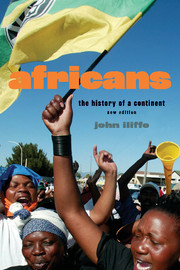Book contents
- Frontmatter
- Contents
- List of maps
- Preface to the second edition
- Africans
- 1 The frontiersmen of mankind
- 2 The emergence of food-producing communities
- 3 The impact of metals
- 4 Christianity and Islam
- 5 Colonising society in western Africa
- 6 Colonising society in eastern and southern Africa
- 7 The Atlantic slave trade
- 8 Regional diversity in the nineteenth century
- 9 Colonial invasion
- 10 Colonial change, 1918–1950
- 11 Independent Africa, 1950–1980
- 12 Industrialisation and race in South Africa, 1886–1994
- 13 In the time of AIDS
- Notes
- Further reading
- Index
- Books in the series
12 - Industrialisation and race in South Africa, 1886–1994
- Frontmatter
- Contents
- List of maps
- Preface to the second edition
- Africans
- 1 The frontiersmen of mankind
- 2 The emergence of food-producing communities
- 3 The impact of metals
- 4 Christianity and Islam
- 5 Colonising society in western Africa
- 6 Colonising society in eastern and southern Africa
- 7 The Atlantic slave trade
- 8 Regional diversity in the nineteenth century
- 9 Colonial invasion
- 10 Colonial change, 1918–1950
- 11 Independent Africa, 1950–1980
- 12 Industrialisation and race in South Africa, 1886–1994
- 13 In the time of AIDS
- Notes
- Further reading
- Index
- Books in the series
Summary
modern south africa deserves separate treatment, because the discovery of gold at the Witwatersrand in 1886 gave the south a trajectory different from the rest of the continent, moving towards an industrial economy, the entrenchment of local white power, and a unique system of racial repression culminating in the apartheid programme of 1948, a centrally imposed programme of racial segregation under white domination. Yet although South Africa was as distinct from the rest of the continent as Pharaonic Egypt, it shared many underlying historical processes. The most fundamental was demographic growth, from perhaps three million or four million in 1886 to thirty–nine million in 1991. As elsewhere, this bred competition for rural resources, mass urbanisation, generational conflict, and the overextension of the state. In the early 1990s, these conditions, together with industrial development and the international context, enabled black people to force their rulers to seek security in a long-term settlement. Majority rule in 1994 left South Africa facing the socio-economic problems troubling the whole continent, but its peak population growth rate was past and it possessed skills and resources making those problems potentially easier to surmount.
MINING AND INDUSTRIALISATION
The Witwatersrand goldfield in 1886 differed greatly from the early diamond diggings at Kimberley. There were no black claim-owners, for the Witwatersrand was not in the officially multiracial Cape Colony but in the South African Republic (Transvaal), whose Afrikaner government immediately confined mining claims to white men.
- Type
- Chapter
- Information
- AfricansThe History of a Continent, pp. 273 - 287Publisher: Cambridge University PressPrint publication year: 2007

